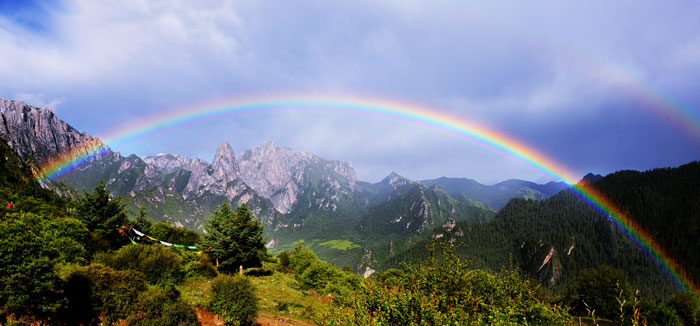Diebu Zhagana Agriculture-Forestry-Animal Husbandry Composite System, China
GIAHS since 2017

Global importance
Zhagan is located in the three major landforms of the Tibetan Plateau, the Loess Plateau and the Chengdu in China. It also lies in the convergence zone of the three climatic zones conditioning the natural vegetation and soils. Thanks to their adaptation, farmers have developed huge knowledge and various technics to recycle and rational the utilization of the resources of land, forest, grassland and species. The special location has created the blend of unique natural and cultural landscape, nomadic, Tibetan Buddhist and folk culture.
The nomadic culture, farming culture, forest culture and Tibetan Buddhism culture are long-term complementary, which forms the irrigated farming, in river, mountains and woodland as well as grassland and cerebral mountain grazing.
Food and livelihood security
The compound production of agriculture, forestry and animal husbandry helps to meet the need of the local people’s lives: each family unit can be provided a variety of production materials and necessities of life. Indeed, this system forms a relatively complete and self-sufficient economic unit, which can ensure local people’s food supply and livelihood security. First of all, it allows to ensure the needs of the normal life of farmers providing flour, vegetables and other food but also proteins with milk, meat but also fur. It also helps to get fertilizers and forage for the animals’ husbandry.
Forestry provides many materials for traditional Tibetan dwelling, agricultural tools but also medicines products, fungi, herbs, tree gum but also paint turpentine, spices etc. 545 kinds of medicines have been recorded in the Tibetan medicine resources list.
Biodiversity and ecosystem functions
Being at the boundary of various ecological zones, the cultivated and natural biodiversity is high, adapted to each habitat depending on the altitude but also on the climate. Cultivated crops are 23 and are mainly barley, beans and rape. Wildlife is abundant and participate to the maintenance of the stability of the system and the function of ecology. Indeed, natural and wild biodiversity is very rich and gather 1600 species among which, 11 kinds of wild and rare plants and 10 of animals which are national protected.
Forest area is the largest, accounting for 58% of the total area. Pasture accounts for 30% of the total area, and the arable land for nearly 20%. Maintaining and protecting the forest plays a very important role in reducing soil erosion as well as the grassland ecosystem avoiding overgrazed and uncovered soils. It also plays a role in the water conservation thanks to its infiltration in the soils. It can reduce the peak flow, delay pick arrival time, etc.
Knowledge and adapted technologies
The residents engage different occupation such as nomadic farming, hunting, cutting woods, etc. This system forms the irrigated farming, in river, the interphase in mountain and woodland as well as grassland and cerebral mountain grazing, such as a vertical and three dimensional multiple type of economy.
Animal husbandry product is mainly based on a nomadic production. Crops are managed thanks to a rotation fallow system. The rotation fallow system of farmland is implemented in order to maintain the soil fertility. Barley-potato-broad bean, spring wheat-rape-broad bean are the forms of the rotation system. It helps to maintain the soil vitality. Barley is planted the first year, the potatoes are planted in the second year, broad beans are planted in the third year and the land is fallow in the fourth year. Fallow period lasts 1 year. The crops protection is mainly based on prevention method and comprehensive integrated control mainly selecting resistant varieties.
The whole system includes agroforestry systems with terraces built at high altitudes, the co-dependence between agriculture and animal husbandry providing fertilizers, but also forestry and animal husbandry notably to breed the local Juema pigs. Pigs find the food by themselves during low production seasons.
Culture
Agriculture is strongly linked to culture: taboos help to control the practices of cutting forests, hunting, etc. containing environmental protection consciousness. It also includes praying for the God of lands before digging in the crop growing areas.
Local culture is very rich with influences from Tibetan Buddhist culture and Han’s farming culture that were introduced into and adapted to the special conditions of the composite ecosystem of agriculture, forestry, animal husbandry, which gradually formed the special cultural features and social organization of Zhagana. Several festival culture are famous and linked to praises Gods of Mountains or natural elements. Cuisine, Tibetan medicine culture, architectures, water mills are example of the huge local culture.
Landscapes, land and water resources management
Local landscape is very unique because of its specific location gathering several eco habitats. Oriented by the Yiwa River, the landscape is regularly scattered by farmlands on the slope, with fields, river, residence and temples that attach radiance to the surrounding mountains, forming rural living space of lingering charm. The whole space sequence progress linearly, which arranges as natural landscapes change and forms scenes in combinations of movement and dynamic density catering and artistic imageries so that the Zhagana rural landscape get to be realized and showed fully.
Human activities mainly gather on the bottom. These constituents in vertical space maintain good region circle of settlement ecosystem, and they are necessity for farmland management as well as a mental want for people’s agriculture production in mountains.
Land and water management are mainly based of fallow system and taboos.

